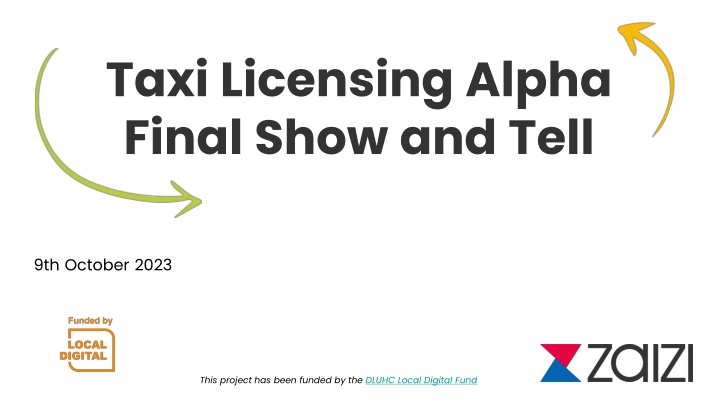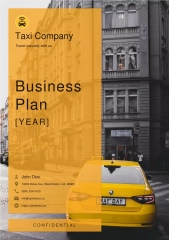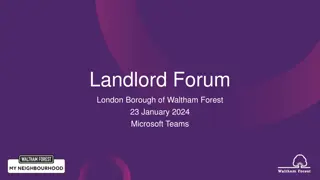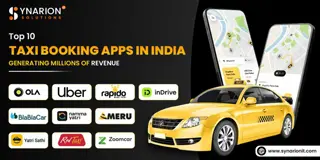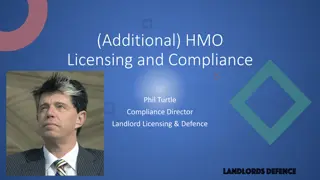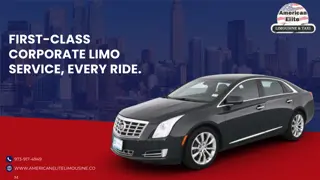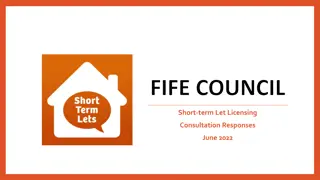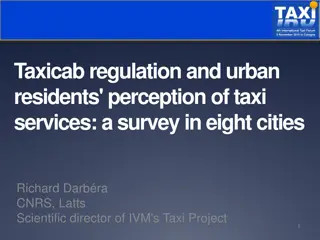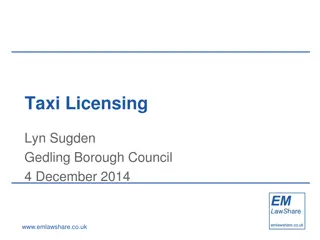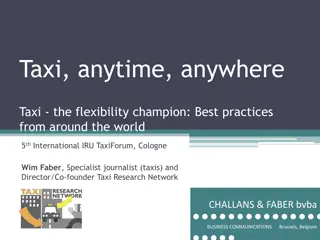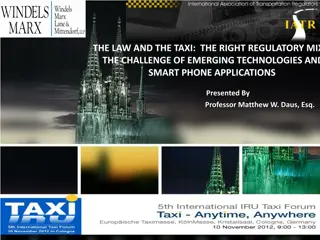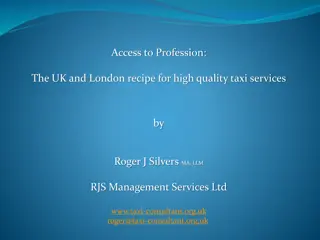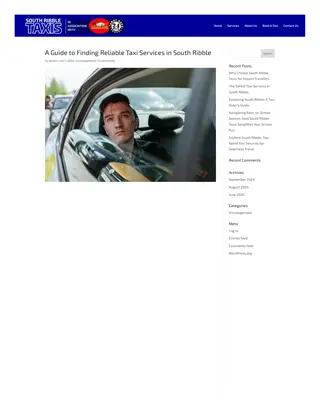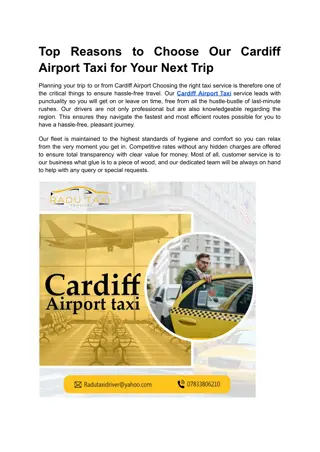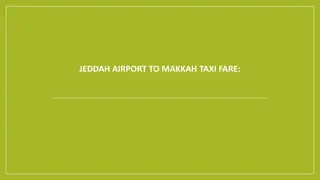Taxi Licensing Alpha Final Show and Tell
Establishing criteria, testing solutions, and user research findings for improving taxi licensing processes through digitization. Insights on barriers faced by license holders, solution testing, and round 1 user research results.
Download Presentation

Please find below an Image/Link to download the presentation.
The content on the website is provided AS IS for your information and personal use only. It may not be sold, licensed, or shared on other websites without obtaining consent from the author.If you encounter any issues during the download, it is possible that the publisher has removed the file from their server.
You are allowed to download the files provided on this website for personal or commercial use, subject to the condition that they are used lawfully. All files are the property of their respective owners.
The content on the website is provided AS IS for your information and personal use only. It may not be sold, licensed, or shared on other websites without obtaining consent from the author.
E N D
Presentation Transcript
Taxi Licensing Alpha Final Show and Tell 9th October 2023 This project has been funded by the DLUHC Local Digital Fund
Agenda Alpha Structure The Problem Hypotheses Testing UR Findings Prototype Demo Proposed Solution Benefits Risk GDS Due Diligence Beta Scope Operating Models Further Recommendations
Alpha Structure Establishing Success Criteria Understanding the Landscape Kick off Establishing User Needs Stakeholder Interviews Assess Desirability Problem Statement UR Workshop Recommendations As is Service Blueprints Alpha Goals and Problem Hypotheses Ideation Workshop Future Vision Participant Recruitment As is Process Mapping Prototype Design Product Metrics Participant Interviews Participant Recruitment UR Synthesis Prototype Testing Assess Feasibility Policy Constraints Financial Constraints Tech Constraints
The Problem 1. Barriers to timely engagement with Licence Holders 1. Licence holders depend upon a range of complex government and non-government services 1. Taxi Licensing is a lifecycle, not a single transaction 1. The licensing teams have to ensure that drivers remain compliant 1. Licensing Team policies on communications We believe that digitising the taxi "Manage my licence" service will improve outcomes by simplifying the service. It will create a sense of ownership for licence holders and streamline the business process.
Testing the Solution Hypothesis to test Experiment carried out Conclusion drawn If we make it easier for licence holders to interact with and understand the service, then we will see proactivity increase. Licence holders will then have a better understanding of what is required. Our desk research and round 1 of user research There is no single source for licence holders to understand all upcoming checks and deadlines. Usability testing using a prototype of a proposed digital service Positive feedback on the prototype If we improve the desirability of the service for the drivers they are more likely to use it and be comfortable with it. Usability testing with a simplified design. We ensured that the design contained elements that were uncovered in the first round of user research. The prototype design received positive feedback with some suggested changes. More details can be found here.
User research - Round 1 findings User research - Round 1 findings Licence holders need: To be able to complete applications, for example when they change vehicles or decide to become their own operator, as well as renewals To be able to track the progress and status of their application/renewal Have everything in one place - MOT, DVLA, DBS, etc. - to bridge the gap between all the different documents and applications To submit copies of their licence forms and documentation with access to any technology, such as printers or scanners, required to do so Reminders of upcoming renewals and/or actions that need to be done as a part of managing their licence, to be able to choose how to receive them, and to know how far in advance to complete an action To know if they've made mistakes/errors in their application/renewal to avoid delays to their application
User research - Round 1 findings User research - Round 1 findings There is a perception among drivers and operators that there are a lot of low digital and english as second language (ESL) drivers in their local area Licence holders with low digital skills, dyslexia or ESL need: To be able to speak to, or get a response from, the licensing team in a faster way Access to support from licensing teams to complete their application/renewal where online solutions or technologies are involved Access to support with cashless payments Application/renewal forms to be simple, streamlined and accessible, use simple language, and not be too wordy
Prototype demo! Prototype Demo To do / pending / completed task list Status tags for tasks Details of current licenses External help links throughout the task journey Applying for a new license Profile and settings inc. contact preferences
User research - Round 2 findings User research - Round 2 findings Prototype feedback: A majority of drivers and operators felt that the application would save them time, out of not needing to travel to the council office and the digital service enabling them to complete licence renewals themselves A majority of drivers and operators found the prototype designs and its task-based concept simple to use. Of those probed, users felt it would improve the current service due to less paperwork and its simplicity The most common usability issues drivers had using the application were upon completion of a task. It appears in the pending tab and some drivers became confused if they needed to finish the task Both driver and operator user groups had expectations around receiving reminders for all outstanding tasks. They also mentioned a need to receive notifications when any task moves from pending to complete or is returned to them for further work by the licensing team
User research - Round 2 findings User research - Round 2 findings Licence holders with low digital skills, dyslexia or ESL: Two low digital drivers, one driver with dyslexia and one ESL driver were not able to use the application by themselves on a tablet device and indicated that they would need in-person assistance Driver and operator user groups mentioned that they are aware of a lot of drivers who may struggle to use the application without support in the form of training, step-by-step guides, or assistance from licensing teams Most operators indicated they would be comfortable and happy to support low digital, English as a second language and drivers with accessibility needs using the application in-person* Drivers and operators supported the idea of this service being a mobile application as they have the perception that most drivers have smart devices and are accustomed to using other mobile apps as a part of their role as a driver
Testing the Solution Hypothesis to test Experiment carried out Conclusion drawn If we create alignment within the councils we can realise a more streamlined and efficient service Interviews with licensing teams Creating service blueprints and as-is process flows per council Concluded that services had a common foundation that could be built upon. However, the differences between the councils that exist are ways of working and will require significant effort to align. There is more effort than value in creating this alignment. For the Beta, this would mean that we work with the common foundations and accommodate the differences within the operating model being suggested If we create specific services aligned to each of the councils we can realise a more streamlined and efficient service Interviews with licensing teams Creating service blueprints and as-is process flows per council Concluded that services had a common foundation that could be built upon. However, the differences between the councils that exist are unique ways of working and will require significant effort to align. There is more effort than value in creating this alignment. For the Beta, this would mean that we work with the common foundations and accommodate the differences within the operating model being suggested
A Digital Front Door Service Product Vision The Solution The service becomes a one-stop shop for licence holders to see what is required during the life of a licence. Rather than a purely transactional service this gives visibility and clarity of the activity between the licence holder and the licensing communication throughout the life of the licence, in turn allowing the purpose of public and transport safety to be met team and better Future Vision It becomes the go-to service to meet all licence holder needs when managing, maintaining and applying for taxi licences. The online licensing service evolves into the preferred platform of communication between the licence holder and the licensing team. It can be leveraged as a potential service for other areas of licensing. It creates a useful experience of licensing rather than being a burden and, in turn, continues ensuring that public and transport safety is at the forefront. It becomes THE standard for the taxi trade and integrates within the taxi landscape as any other GOV.UK service.
The Qualitative Benefits 1. Modernise communication within the taxi trade 1. Increase visibility and transparency for the licence holders 1. Removing blockers that reduce proactivity of the licenceholder 1. Scalable Solution
The Quantitative Benefits Product Goal Product Metrics Reduce time on back end processes that directly impact the licence holders Reduction in cost and time spent chasing to ensure licence validity Reduce time on back end processes that directly impact the licence holders Increase staff time availability to use on other, more valuable proactive licence administration Create a simplified and desirable service for managing licences Reduction in number of drivers going through escalation process to ensure licence validity Improve proactiveness of Licence Holders Reduction in number of suspensions due to failure of compliance Create a simplified and desirable service for managing licences Reduction in number of new applications that are processed due to missed renewal dates Improve proactiveness of Licence Holders
Risks Phase of Work Required Risk being Addressed Level Integration with back end process Beta Phase High Risk (Must be done) Drivers with high number of Licences Beta Phase High Risk ( Must be done) Testing with other councils Beta Phase Medium Risk (Should be done) New applications Alpha Phase Low Risk (Could be done) Operator needs arising from the operator-and-employed-driver relationship Alpha Phase Low Risk (Could be done)
Criteria Met Commentary Understand users and their needs Explored the needs of the following Licensing Teams Drivers Operators Vehicle Proprietors GDS Due Diligence Solve a whole problem for users The users have indicated new applications and payments within the research that was conducted. To solve the whole problem these elements will need to be considered as part of the live service Make the service simple to use The prototype was refined by understanding the needs of the users. Research synthesis indicates that most users find the proposed digital front door service easy to use. Have a multi-disciplinary team Use agile ways of working Iterate and improve frequently Create a service which protects user's privacy The technical architecture that has been designed considers this. The recommendation for this is a one-time password for user authentication as used with other digital services. Define what success looks like and publish performance data Success would mean that the amount of time and effort spent chasing licence holders would reduce. There are metrics(need to insert link here) that indicate the success of the service Choose the right tools and tech Make new source code open The operating models recommend this approach Use and contribute to open standard common components and patterns Operate a reliable service
Now Next Later Beta Scope Additional Operator Needs Viewing Licence Details Setting reminders New Applications Store and View Documents Configuring reminder preferences Ability to see outstanding tasks Capture Feedback Submitting documents Contacting Licencing Team Making Payments Testing with other councils Ability to see approval progress Visualising high number of licences Beta Phase Additional Alpha Phase Future Considerations
Option 1 (Local) Option 2 (Open) Option 3 (Common) Operating Model Descriptor We deliver a front-end digital service that each of the local councils can take and integrate with their back-end systems. We deliver a front-end digital service that addresses the common needs across councils. The service is provided as an Open Source project which councils can use and contribute back into. We deliver a front-end digital service alongside local councils. A central team manages and supports the service for all councils. Operating Model Options How adaptable is the solution to new legislative changes? Depends on the local council's capacity Depends on local council capacity and private partnerships with suppliers Cost of maintaining a team governs the new features and prioritises development. How easy is it to onboard new councils to service? New councils will need to take the provided Beta and develop their own solution based upon it New councils will need to take the provided Beta and develop their solution based upon it or partner with a supplier to do the same New councils will be added by the service team Process Alignment Divergent except for agreed aspects during Beta Some convergence due to Open Source Model Gradual convergence on onboarding users and other processes whilst retaining configurability per council Technical Architecture Single tenancy cloud solution (each council hosting) Mix of single tenancy and multi-tenancy solutions (based on council capability and delivery partners) Multi-tenancy cloud solution (shared hosting) Governance Local Councils The board is drawn from the councils Digital Service Program Team Next steps after the Beta Each council takes the digital service and integrates it with their back office systems. Hosting, support and maintenance become each council s own responsibility. The Open Source model is adopted where councils take the Beta and make their own changes. These changes should be shared back with the wider service-using community. A single service team is responsible for the integration of the service with different council's back office systems. This team would make further changes as needed.
The recommended approach is: Research Recommendations Qualitative user research We would recommend that further prototype testing be conducted with mobile devices to measure any changes in how low digital users adapt to the application If new applications were to be considered in scope for this service, further research would be needed with participants who are considering or are in the process of applying for a licence to understand their needs Research will be needed to understand how payments currently work across councils for licensing and how it would work within this application Quantitative user research The scale of the key user needs identified across a broader range of local councils and their respective licensing teams and licence holders The population size of low digital, accessibility and ESL drivers. Quantifying this will help in understanding how much time will be needed to support these users and what kind of offline service support will be required
Future research logistics and recruitment Future Recommendations Pop-up research at taxi ranks operator offices has proven most successful in reaching drivers, including those with low digital or accessibility needs Future pop-up thought should go into the timing of visits, whether licensing teams should be present to minimise participant bias, and offering incentives so that drivers can stay focused on the session Future in-person research We recommend the following for any scheduled in-person research sessions: There is anxiety among drivers about going to the council office so future research should be conducted at more neutral locations We encountered a lot of difficulty recruiting drivers through local council contacts and would recommend the use of recruitment agencies Incentives must be offered for future user research as the absence of this drastically affected the turnout of drivers for research sessions
Upon completion of the project, we have six considerations for the future that we would recommend be fully developed for a successful live digital licensing service. Future Considerations These are: Deeper integration with other GOV.UK services to improve the application renewal process for licence holders Enable licence holders to apply for new licences online which would create a smoother transition for licence holders and the licensing team Booking tests and checks online so that the licensing team don t need to send individual reminders to licence holders in more than one way Creating a more rounded operator-focused aspect to the service and cater to those who have to oversee multiple licences A document storage system to help all users easily and quickly submit documents to the licensing teams and create peace of mind Feedback on the licensing team to improve their relationship with licence holders and create a better working system between both users as feedback on issues can be received quicker
Recommended Model Delivery partner working across councils to provide a common hosted cloud-based solution. Multi tenancy approach - removes responsibility for maintaining and supporting own version of service Delivery coordinate across the councils helping achieve the vision of a standardised Taxi Platform partner will help create alignment and
Thank you! Q&A
